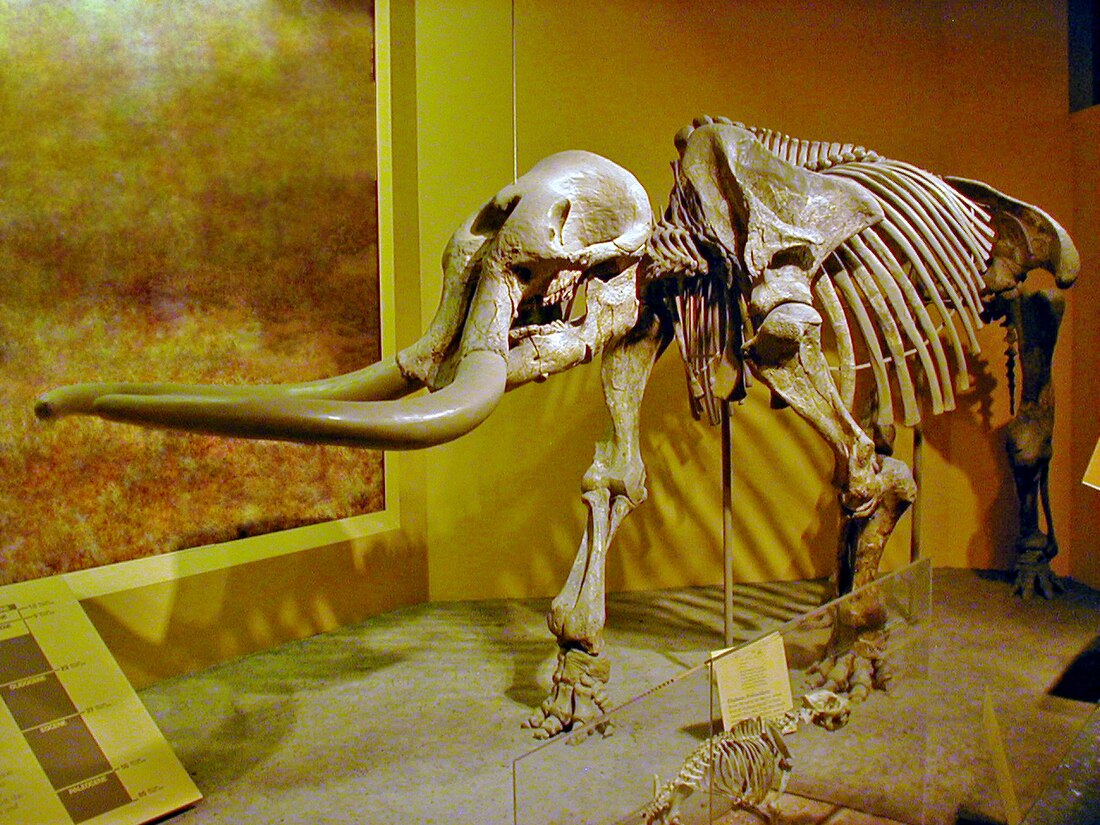Top Qs
Timeline
Chat
Perspective
Stegomastodon
Extinct genus of mammals From Wikipedia, the free encyclopedia
Remove ads
Stegomastodon ('roof breast tooth') is an extinct genus of gomphotheres. It ranged throughout North America from the Pliocene (early Blancan ~4 Ma), to the Early Pleistocene (early Irvingtonian, ~1.2 Ma). The former South American species have been synonymized with Notiomastodon platensis.
Remove ads
Description

Stegomastodon mirificus is known from NMNH 10707, a roughly 30-year-old male, of which most of the skeleton has been found. Alive, it stood about 2.6 m (8.5 ft) tall, with a weight around 4.7 tonnes (4.6 long tons; 5.2 short tons).[1] Unlike more primitive gomphotheres like Gomphotherium, it lacked lower tusks and had a shortened lower jaw. The upper tusks curved upward and were about 3.5 m (11.5 ft) long, and lacked enamel bands. The tall head and robust lower jaw suggest a strong vertical bite. Stegomastodon's third molars molars had at least 5 lophs (ridge-like structures), greater than previous gomphotheres. The strong bite and increased tooth complexity are suggested to be adaptations to a grazing diet.[2]
Remove ads
Origin and evolution
Stegomastodon is suggested to have ultimately originated from New World populations of Gomphotherium, possibly via the intermediate genus Rhynchotherium.[3] The earliest species of the genus appeared during the Pliocene (Blancan) around 3-4 million years ago. During the early Irvingtonian, around 1.2 million years ago, Stegomastodon became extinct, which is suggested to be due to competition with the recently arrived mammoths, which were more efficient grazers.[3] Originally, some specimens from Jalisco, Mexico were estimated to date to 28,000 years Before Present,[4] but this age was rejected in 2011 by Spencer G. Lucas et. al, who stated that the date was far too young to be viable and that it actually dates to the Blancan.[2]

Remove ads
Taxonomy

The number of species within the genus has varied between S. mirificus being the only valid species, to Osborn's seven species of “ascending mutations” (S. primitivus, S. successor, S. mirificus, S. chapmani, S. texanus, S. arizonae and S. aftoniae) Lucas et al., 2013 accepted three overlapping chronospecies: S. primitivus, S. mirificus S. aftoniae.[5] The South American Stegomastodon fossils have been reassigned to Notiomastodon by the majority of recent authors.[6][7][3] Stegomastodon and Notiomastodon differ in numerous characters, including of the skull and limbs.[3] Revised taxonomy of Stegomastodon and other trilophodont gomphotheres according to Mothé et al., 2017:[8]
†Gomphotheriidae (Gomphotheres) |
| ||||||||||||||||||||||||
References
Wikiwand - on
Seamless Wikipedia browsing. On steroids.
Remove ads

